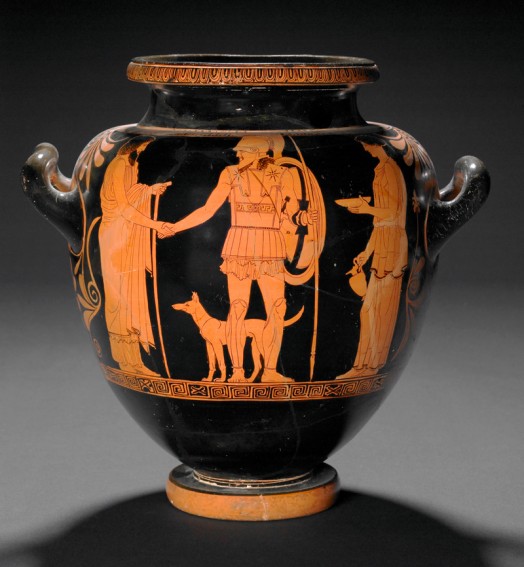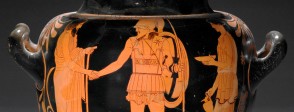
The painting
The scene shows an Athenian family. In the centre stands a man who is clearly a warrior. He wears body armour made of layers of linen glued together so that it was light but strong. He holds a spear and the round shield typical of the heavy infantry called hoplites. At his waist he has a sword. His head and face are protected by a helmet and he wears bronze greaves on his legs. He shakes hands with the man on the left, who is shown to be older through the staff that he carries. These two figures are commonly taken to be father and son. On the right a woman stands holding a wine jug and a special type of bowl, known as a phiale, which was used to pour wine as an offering to the gods. She may be the younger man’s mother or his wife. Although the handshake and the offering to the gods are potentially ambiguous, this scene is interpreted as one of departure for, rather than return from, war.
The younger man
Written sources about Greek and especially Athenian customs of the period allow us to understand something of the background of this representation. When he was a five-day old baby, the young man’s father accepted him into the family by carrying him around the hearth of the family home. If the baby had been weak or sickly, he would probably have been taken outside the city boundary and left to die, though it is suggested by some scholars that the importance of having a son and the high mortality rate of babies might have given him a chance of being rescued by a childless family. After ten days he received his name and for the rest of his early years he was brought up by the women of the household. In Athens, as in most other Greek cities, boys continued their education in the home and through their interactions with the men of the family; the sons of better-off families sometimes had professional teachers or went out to school. At the heart of a young man’s education were the values and skills he needed to take on his future responsibilities as citizen and head of his family: understanding the family business, the skills of argument and public-speaking, knowledge of literature and culture, and especially physical fitness and the arts of warfare. At the age of 21 he was received into the citizen body of Athens and could take part in the running of his city. All male citizens were expected to fight for their city. The very wealthy were cavalry; those who could afford to buy the necessary equipment fought as hoplites; others served as lightly armed troops and, in Athens, the poorest as rowers in the navy.
The older man
At Athens as elsewhere in Greece the family household, known as the oikos, was the basic unit of society. The oldest male was the head of the oikos, which consisted of his wife, his sons and unmarried daughters, the sons’ wives and children and the slaves. He was ultimately responsible for the well-being of the oikos, controlling its property and wealth and arranging his sons’ and daughters’ marriages. Landowning and agriculture were considered the most prestigious ways of earning a living in classical Athens, and even poor farmers were more highly respected than men who made money from commerce or manufacture. Average life expectancy for a man in ancient Greece was around forty years, with only about a fifth of men reaching the age of fifty and fewer again reaching sixty. When the head of the oikos died, his eldest son took over his responsibilities, even to the extent of becoming the guardian of his own mother if she was still alive.
The ideal lifestyle for the Athenian man was to have enough wealth to be able to live a life of public duty, dedicating himself to carrying out his cult responsibilities, taking part in social activities and playing his role as a citizen by holding public office and participating in the political life of the city. Men were very much the public face of the oikos as also of the larger political units in Greece.
The woman
In contrast, an ancient Greek woman’s role was confined almost entirely to the home. Women had two main responsibilities: to run the house and to produce children, preferably sons. Women’s life expectancy was lower than men’s owing to the dangers of childbirth. Girls were married as young as twelve and could be expected to start having children within the first years of marriage. Running the home involved looking after the young children, ensuring the house had the supplies of food and other goods it needed and supervising any slaves in cooking, cleaning and purchasing supplies. Cloth making was an important aspect of a woman’s duties. Because of its practical importance for the oikos, spinning and weaving also acquired a symbolic meaning: where war was the epitome of a man’s role, making cloth was that of a woman.
Women also played an active role in the realm of religion - the woman on this pot is preparing a ritual libation to try to secure the gods’ assistance in allowing her son or husband to return home. Religion was the only arena in which women participated prominently in the public life of the city. Many cults – in the case of Athens, the cult of Athena herself - required priestesses and /or female attendants. Women were also seen playing a public role in the context of funerals and the commemoration of the dead. Wealth and status (free citizen or resident alien) further affected the degree to which a household could afford or wished to forego the labour of women in the fields, fetching water or selling goods in the market in order to keep them isolated in the house.
More information
Overview of the lives of women with further page on dress
http://www.penn.museum/sites/greek_world/women.html
Overview of the lives of men with further pages
http://www.penn.museum/sites/greek_world/men.html
Introduction to women in classical Greece with links to related objects
http://www.metmuseum.org/toah/hd/wmna/hd_wmna.htm
Summary of lives of women, children and slaves in Athens
http://www.ancientgreece.co.uk/staff/resources/background/bg18/home.html
Summary of lives of men and women in Sparta
http://www.ancientgreece.co.uk/staff/resources/background/bg1/home.html
Article about women in Greece in the 300s BC
http://www.historytoday.com/michael-scott/rise-women-ancient-greece
Spinning and weaving basics
http://www.ancientgreece.co.uk/dailylife/explore/spinning.html
Introduction to scenes of everyday life on pots
http://www.metmuseum.org/toah/hd/evdy/hd_evdy.htm
Wine jug showing a woman spinning
http://www.britishmuseum.org/explore/highlights/highlight_objects/gr/w/white-ground_jug,_attributed_t.aspx
John H. Oakley, The Greek Vase: Art of the Storyteller, British Museum Press, 2013
http://www.britishmuseumshoponline.org/invt/cmc22779
More information
-
Overview of the lives of women with further page on dress
Source: penn.museum
-
Overview of the lives of men with further pages
Source: penn.museum
-
Introduction to women in classical Greece with links to related objects
Source: metmuseum.org
-
Summary of lives of women, children and slaves in Athens
Source: ancientgreece.co.uk
-
Summary of lives of men and women in Sparta
Source: ancientgreece.co.uk
-
Article about women in Greece in the 300s BC
Source: historytoday.com
-
Spinning and weaving basics
Source: ancientgreece.co.uk
-
Introduction to scenes of everyday life on pots
Source: metmuseum.org
-
Wine jug showing a woman spinning
Source: britishmuseum.org
-
John H. Oakley, The Greek Vase: Art of the Storyteller, British Museum Press, 2013
Source: britishmuseumshoponline.org


